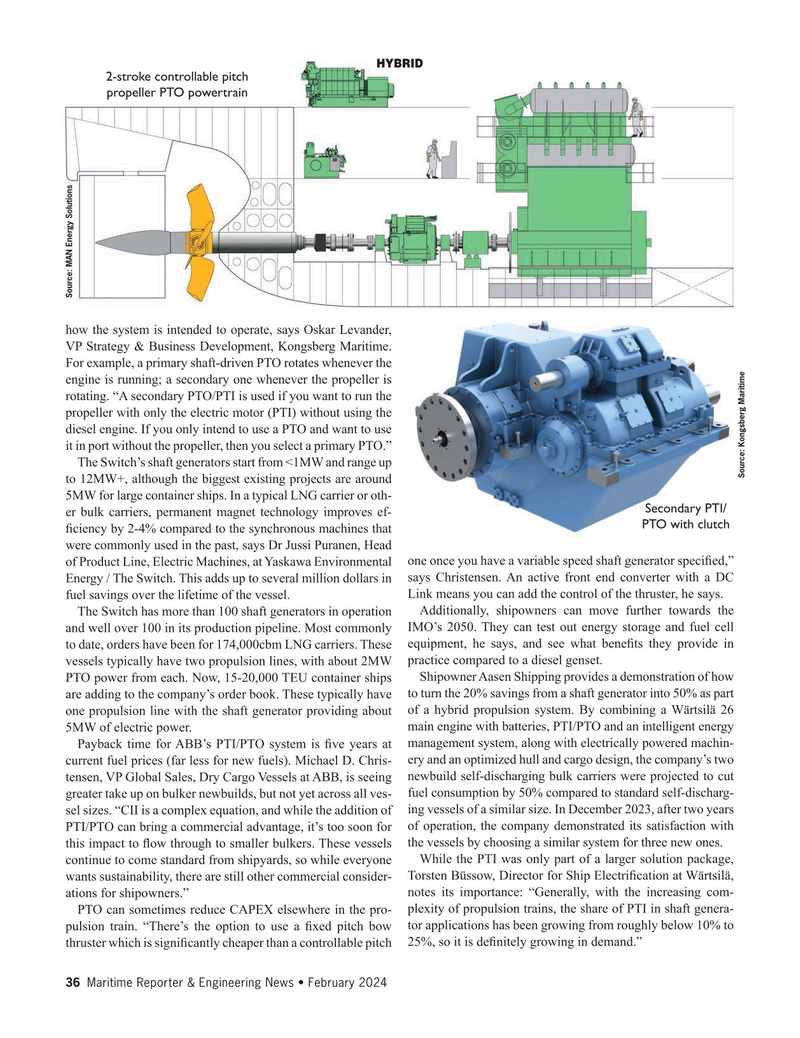
Page 36: of Maritime Reporter Magazine (February 2024)
Read this page in Pdf, Flash or Html5 edition of February 2024 Maritime Reporter Magazine
HYBRID 2-stroke controllable pitch propeller PTO powertrain
Source: MAN Energy Solutions how the system is intended to operate, says Oskar Levander,
VP Strategy & Business Development, Kongsberg Maritime.
For example, a primary shaft-driven PTO rotates whenever the engine is running; a secondary one whenever the propeller is rotating. “A secondary PTO/PTI is used if you want to run the propeller with only the electric motor (PTI) without using the diesel engine. If you only intend to use a PTO and want to use it in port without the propeller, then you select a primary PTO.”
The Switch’s shaft generators start from <1MW and range up
Source: Kongsberg Maritime to 12MW+, although the biggest existing projects are around 5MW for large container ships. In a typical LNG carrier or oth-
Secondary PTI/ er bulk carriers, permanent magnet technology improves ef-
PTO with clutch ? ciency by 2-4% compared to the synchronous machines that were commonly used in the past, says Dr Jussi Puranen, Head of Product Line, Electric Machines, at Yaskawa Environmental one once you have a variable speed shaft generator speci? ed,”
Energy / The Switch. This adds up to several million dollars in says Christensen. An active front end converter with a DC fuel savings over the lifetime of the vessel. Link means you can add the control of the thruster, he says.
The Switch has more than 100 shaft generators in operation Additionally, shipowners can move further towards the and well over 100 in its production pipeline. Most commonly IMO’s 2050. They can test out energy storage and fuel cell to date, orders have been for 174,000cbm LNG carriers. These equipment, he says, and see what bene? ts they provide in vessels typically have two propulsion lines, with about 2MW practice compared to a diesel genset.
PTO power from each. Now, 15-20,000 TEU container ships Shipowner Aasen Shipping provides a demonstration of how are adding to the company’s order book. These typically have to turn the 20% savings from a shaft generator into 50% as part one propulsion line with the shaft generator providing about of a hybrid propulsion system. By combining a Wärtsilä 26 5MW of electric power. main engine with batteries, PTI/PTO and an intelligent energy
Payback time for ABB’s PTI/PTO system is ? ve years at management system, along with electrically powered machin- current fuel prices (far less for new fuels). Michael D. Chris- ery and an optimized hull and cargo design, the company’s two tensen, VP Global Sales, Dry Cargo Vessels at ABB, is seeing newbuild self-discharging bulk carriers were projected to cut greater take up on bulker newbuilds, but not yet across all ves- fuel consumption by 50% compared to standard self-discharg- sel sizes. “CII is a complex equation, and while the addition of ing vessels of a similar size. In December 2023, after two years
PTI/PTO can bring a commercial advantage, it’s too soon for of operation, the company demonstrated its satisfaction with this impact to ? ow through to smaller bulkers. These vessels the vessels by choosing a similar system for three new ones. continue to come standard from shipyards, so while everyone While the PTI was only part of a larger solution package, wants sustainability, there are still other commercial consider- Torsten Büssow, Director for Ship Electri? cation at Wärtsilä, ations for shipowners.” notes its importance: “Generally, with the increasing com-
PTO can sometimes reduce CAPEX elsewhere in the pro- plexity of propulsion trains, the share of PTI in shaft genera- pulsion train. “There’s the option to use a ? xed pitch bow tor applications has been growing from roughly below 10% to thruster which is signi? cantly cheaper than a controllable pitch 25%, so it is de? nitely growing in demand.” 36 Maritime Reporter & Engineering News • February 2024
MR #2 (34-44).indd 36 2/6/2024 8:51:09 AM

 35
35

 37
37
